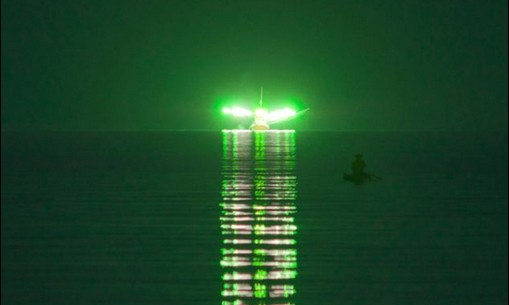
|
A map of the Earth, released by Nasa last year, revealed something fishy going on off the coast of Argentina. Around 300 miles offshore, a city of lights was appearing in the middle of the South Atlantic Ocean. The strange lights were perplexing as there are no humans, fires or gas wells in that region. What is there however, according to Nasa, are fishing boats with lights powerful enough to be seen in space. The lights were spotted using Visible Infrared Imaging Radiometer Suite on the Suomi NPP satellite. According to Nasa, the night fishermen are hunting for Illex argentinus, a species of short-finned squid. The squid are found tens to hundreds of kilometres offshore from roughly Rio de Janeiro to Tierra del Fuego. They live 80 to 600 meters below the surface, feeding on shrimp, crabs, and fish. ‘In turn, Illex are consumed by larger finfish, whales, seals, sea birds, penguins ... and humans,’ said Nasa. Scientists first noted such night-lighting of the seas in the late 1970s and early 1980s, while compiling the first maps of the Earth at night. ‘Squid aggregate in high concentrations at the shelfbreak because it is a very productive area during austral spring and summer,’ explained Marina Marrari, a biological oceanographer with Argentina’s Servicio de Hidrografia Naval. At the shelfbreak front, microscopic plant-like organisms explode in population in various seasons. This ‘grass of the sea’ feeds zooplankton and fish, which then become food for Illex argentinus and other marine creatures. To draw the plankton and fish that the squid eat to the surface, fishermen use powerful lights, generating as much as 300 kilowatts per boat. Squid follow their prey toward the surface, where they are easier for fishermen to catch with jigging lines. For many squid, the zooplankton and fish they follow is the last meal they will eat. In the South Atlantic, Argentine and Falklands citizens have exclusive rights to fish out to 200 miles. As the map suggests, ships from other nations work as close to that border as they can to get a share of the squid fishing. |
去年,美國(guó)國(guó)家航空航天局(NASA)發(fā)布了一張地球衛(wèi)星圖,圖片顯示,在南大西洋中心,離阿根廷海岸300英里(約483公里)處有一些可疑的“城市燈光”出現(xiàn),這令人十分費(fèi)解,因?yàn)槟瞧瑓^(qū)域既沒(méi)有人類(lèi)居住,也不是起火,也沒(méi)有天然氣井。 這些神秘光點(diǎn)到底是什么呢?據(jù)《每日電訊報(bào)》10月25日?qǐng)?bào)道,NASA稱(chēng)那些光其實(shí)來(lái)自漁船,由于光照很強(qiáng),在太空都能看到,suomi npp衛(wèi)星用可見(jiàn)紅外成像輻射儀套件(viirs)捕捉到了它們。 這些晚上作業(yè)的漁船正在捕撈阿根廷滑柔魚(yú),這是一種短鰭魷魚(yú),分布在巴西的里約熱內(nèi)盧到南美洲的火地島一線離海岸數(shù)十到數(shù)百公里的海域。 滑柔魚(yú)生活在海面以下80到600米,以蝦類(lèi)、蟹類(lèi)和一些魚(yú)類(lèi)為食,而它本身則是較大的長(zhǎng)須鯨、鯨魚(yú)、海豹、海鳥(niǎo)、企鵝等海洋動(dòng)物的食物,當(dāng)然,也是人類(lèi)的盤(pán)中餐。 阿根廷生物海洋學(xué)家瑪麗娜·馬拉里說(shuō):“滑柔魚(yú)在陸架坡折區(qū)匯集,密度非常高,因?yàn)樵谀戏降拇杭竞拖募荆@里很富饒。” 在陸架坡折向陸一側(cè),各個(gè)季節(jié)浮游植物都會(huì)呈爆炸式增長(zhǎng),這片“草的海洋”為浮游動(dòng)物和魚(yú)類(lèi)提供了豐富的食餌,是滑柔魚(yú)的捕食場(chǎng)。 漁民們用300千瓦的強(qiáng)燈光將滑柔魚(yú)的獵物吸引至海面,當(dāng)滑柔魚(yú)追隨獵物來(lái)到海面后,便成了“甕中之鱉”,對(duì)大多數(shù)滑柔魚(yú)來(lái)說(shuō),這將是最后的晚餐。 20世紀(jì)70年代末至80年底初,科學(xué)家在繪制第一張晚上的地球地圖時(shí),首次注意到這種“海上夜明燈”。 相關(guān)閱讀 美國(guó)國(guó)安局被指30天收集1240億份電話數(shù)據(jù) 斯諾登稱(chēng)沒(méi)有將機(jī)密文件帶往俄羅斯 (譯者 聞竹 編輯 Julie) |
